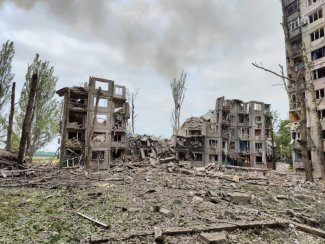More massive attacks on Ukraine. Day 459 of the war

On the night of 28 May, the Russians launched a massive attack on Kyiv (the largest to date, according to the Ukrainian government’s assessment) using Shahed-136/131 kamikaze drones. According to the Ukrainian General Staff, only one of the 59 drones launched by the Russians hit its target (earlier, the Air Force Command of Ukraine had reported that 52 out of 54 had been downed). The Kyiv city military administration declared that all the attacking drones (more than 40) had been neutralised; however, three areas of the city had been damaged by falling debris, with one person killed and two injured. As a result of the attack, there were earthquake-like tremors in the capital, which mayor Vitali Klitschko explained as resulting from moving a powerful new weapon to the front. In addition to Kyiv, Zhytomyr was also targeted by Russian drones.
A further attack came on the night of 29 May. According to the Air Force Command, the defenders knocked out 37 of the 40 Kh-101/Kh-555 cruise missiles and 29 of the 35 Shahed-136/131 kamikaze drones used by the invaders. As before, the main target was Kyiv, whose air defence neutralised all the missiles and drones (more than 40 devices in total). As a result of the falling debris, buildings and infrastructure in and around several areas of the city (including Brovary) were damaged. The most serious damage was reported in the Khmelnytskyi oblast, where the local administration announced that several buildings had been hit, including military facilities (fuel and armament depots). In Odesa, drone debris was said to have damaged the port. Damage as a result of falling debris was also reported from the Zolochiv raion in Lviv oblast, as well as the Kirovohrad oblast, where rail infrastructure was damaged.
At around midday Kyiv time on 29 May, news emerged of yet another wave of attacks. Explosions and falling debris were noted in two areas of Kyiv. Due to the relatively short time between the announcement of the alert and the start of the strike, Air Force Command spokesman Colonel Yuri Ihnat did not rule out the possibility that the invaders had used Iskander-M ballistic missiles or missiles from S-300/S-400 systems.
The invaders also continued their rocket and drone attacks in the frontline zone. Targets included Kramatorsk (Russian missiles, possibly including Iskander missiles, fell on the city twice), Lyptsi in the Kharkiv oblast and Olhivske in the Zaporizhzhia oblast. A medical facility in Dnipro was hit by rocket attacks on 26 May; the death toll there amounted to four dead and 32 wounded. Russian artillery and air forces are continuing to shell and bombard areas along the contact line and near the border. Outside the combat areas, Kherson, Nikopol and Ochakiv remain the main targets in the defenders’ immediate vicinity.
The Ukrainian army intensified its shelling of the hinterland of enemy forces. Virtually every day there have been attacks on Berdyansk, Mariupol (according to local Ukrainian authorities, the invaders have removed the dead and wounded from the city) and Melitopol. According to Ukrainian defence minister Oleksiy Reznikov, the Storm Shadow cruise missiles received from the UK have proven to be 100 per cent effective. Meanwhile the Russian side has reported that Ukrainian drones once again attacked a thermal power plant in Belgorod and a refinery in Krasnodar krai. A transmission infrastructure facility in the Pskov oblast was also sabotaged. There have been no reports on what impact these strikes have had.
Activity by both sides in the combat areas has continued to fall off. The Ukrainian General Staff estimated the number of hostile attacks at 20 per day, with more than half of them (14 on 27 May and 12 on the 28th) falling on Marinka and its surroundings. In the area of Bakhmut, clashes occurred sporadically, and the Russians attacked enemy positions in different place every days: in the area of Khromove and Ivanivske, which are close to the town; Orikhovo-Vasylivka, north-west of Bakhmut (according to some sources, the defenders have occupied a piece of so-called ‘no man’s land’ there), and Predtechyne on the eastern outskirts of Kostiantynivka (which confirms that the invaders have retained their positions on the western side of the Donets-Donbas canal). According to Ukrainian deputy defence minister Hanna Malar, the defenders halted their movements in the Bakhmut area in order to carry out other tasks. The invading forces were expected to slightly expand the area under their control in the Masiutivka area north-east of Kupiansk. Meanwhile, there was a halt in the active operations on the border of Luhansk and Donetsk oblasts over the weekend, as well as in the Avdiivka area on 28 May, where a rotation of units is most likely underway.
On 26 May, the Canadian defence ministry stated that the delivery to Ukraine of a million 5.56 mm-calibre rifle cartridges and 4800 carbines – part of a support package announced in April, comprising a total of 21,000 small arms of various types and 2.4 million cartridges for them – would be finalised in the coming weeks. On the same day, the German embassy in Kyiv reported that over the previous week the Ukrainians had received a TRML-4D radars, two Biber armoured bridgelayers and 54 Vector reconnaissance drones, the delivery of which fulfils Germany’s previous commitments. By contrast, on 27 May, Der Spiegel reported that Ukraine had formally asked Germany whether it could provide Taurus cruise missiles. As quoted by the New York Times, a Pentagon representative stated that 400 Ukrainian soldiers would take part in training on Abrams tanks (half of them as battalion personnel and the other half as machine maintenance). Earlier, the Americans reported that 250 Ukrainian servicemen had begun training.
On 26 May, the eighth Project 58155 Gyurza-M-class gunboat Bucha went into service with the Ukrainian Navy. Unlike its predecessors, which have been sent to the Black Sea, the Bucha will operate as part of Kyiv’s river flotilla squadron. This is the first ship produced in Ukraine since 24 February 2022; it was constructed at the Kyiv river shipyard. There are currently four vessels of this type in service. According to reports, the Bucha has already taken part in defending the capital against attack, and its crew have shot down one drone.
On 27 May, Russian deputy foreign minister Mikhail Galuzin presented a catalogue of demands to Kyiv which could lead to peace if met. Ukraine is to renounce joining the EU and NATO and cease hostilities, and Western states are to stop supplying it with armaments. Other conditions include ‘de-Nazification’, acceptance of its status as a ‘neutral’ and ‘non-aligned’ state, recognition of the “new territorial realities that have arisen as a result of the realisation of the peoples’ right to self-determination”, and ensuring the protection of the rights of Russian-speaking citizens and giving Russian the status of a state language. According to Mykhailo Podolak, chief advisor to the Ukrainian President’s Office, Moscow’s demands testify to its inability to assess the situation realistically, and Kyiv’s conditions for ending the war are the immediate withdrawal of all occupation troops, the final recognition of the collapse of the USSR and the confirmation of the sovereignty of post-Soviet countries, the extradition of war criminals, the creation of a demilitarised buffer zone along Russia’s borders and a reduction in the number of offensive weapons, followed by the introduction of international control over Russia’s nuclear arsenal. In addition, Kyiv is demanding a negotiated programme of war reparations, including the voluntary relinquishment to Ukraine of Russian assets sequestered in other countries.
Also on 27 May Vasyl Malyuk, the head of the Security Service of Ukraine, revealed that more than 300 Russian agents had been unmasked during 2022. He added that some of them had been successfully turned, allowing them to spread misinformation to the enemy.
On the same day Oleksiy Danilov, the head of the National Security and Defence Council of Ukraine, stated that the Ukrainians were ready to launch the long-awaited counter-offensive. However, he declined to give specific dates: in his view, this would happen when, according to military estimates, the armed forces “would be able to achieve the best result possible at this stage of the war”. Danilov thus referred to the rumours that circulated in the media after a recording was leaked in which Valerii Zaluzhnyi, Commander-in-Chief of the Armed Forces of Ukraine, said that “the time [had] come to take back what is ours”. Podolak asserted that Ukrainian troops had begun preliminary activities to prepare the counter-offensive. He indicated that regaining the occupied territories would be a complex process, which includes paralysing enemy supply lines and destroying warehouses behind the front line. He announced that Russian saboteurs would renew their attacks on Russian territory.
Also on 27 May, Ukrainian military intelligence spokesman Andriy Yusov admitted that valuable intelligence had been obtained during the diversionary operation conducted by Russian volunteers in Belgorod oblast. He added that the Russian guerrillas’ task is to liberate the country from Vladimir Putin’s regime, and that resistance forces will operate both in the border regions and around Moscow. He also warned against overestimating such activity: as he said, it would not change the situation on the frontline, but it does oblige the enemy to regroup their forces.
Commentary
- The increasing intensity of the missile attacks both sides are carrying out on the enemy’s resources and infrastructure (which the Russians are doing on a much larger scale) suggests that they are making preparations for a renewed offensive. At the same time, they are aimed at making it more difficult for the enemy to take offensive and defensive actions. The Ukrainian attacks are focused on disrupting Russian activity in the hostile hinterland on the border of Zaporizhzhia and Donetsk oblasts; this indicates that Kyiv still sees cutting off Crimea from its overland connection to Russia as the main objective of the announced counter-offensive. The Russian attacks on the defenders’ deep hinterland lead us to assume that their main objective is to deplete the potential of Ukrainian forces in general, thus making it difficult or impossible for them to operate on an operational scale, regardless of which direction they choose to strike in. These attacks do not indicate in which main direction they would choose to move. Reports of upheavals as a result of the attack on Kyiv on the night of 28 May lead us to think that the invaders were targeting the city’s underground infrastructure, including command posts.
- The artillery cutter Bucha coming into service is of great symbolic significance. It is not only the first ship, but also the first piece of wide-ranging heavy weaponry Ukraine has produced since 24 February 2022. The completion of the vessel, which was launched as recently as September 2021, was facilitated by the fact that the aggressor did not perceive the Kyiv river shipyard (Kuznia na Rybalskomu) as important for developing Ukraine’s military potential, and so they did not attack it. The military usefulness of the boats manufactured there is low, but – as reports that the Bucha shot down a drone indicate – they can effectively counterattack at least some types of aerial attack coming over the riverbeds (this is how the Russians try to confuse the defenders’ radar).





